M.K. Tod's Blog
November 20, 2025
The Reading Journey with Erin Davies
Erin Davies is a passionate reader. We’ve been connected through social media for quite a long time and I admire Erin’s passion for reading and for sharing her thoughts about the books she’s read whenever she has a chance. She has been blogging about books for more than 10 years – you can find her at Historical Fiction Reader.

Erin is a BIG fan of historical fiction and I thought it would be interesting to have her take on The Reading Journey, just as I’ve invited several authors to share their writing journeys.
Mary: How and when did your passion for reading develop?
Erin: It’s difficult to pinpoint exactly when my love for reading began. Like many readers, I can’t recall a time when I didn’t have a book in my hands. I have vivid memories of enjoying the classics in elementary school and being captivated by high fantasy as a young teen.
I read a considerable amount of historical fiction as a child. The True Confessions of Charlotte Doyle by Avi, King of the Wind by Henry, Time Cat by Alexander, and Both Sides of Time by Cooney were high on my list of childhood favorites, but I didn’t consider myself a genre fan until high school when I stumbled across The Champion by Elizabeth Chadwick. That was my gateway book.
Mary: When and why did you decide to share your reading and reviews with others? How do you interact with other readers? Which platforms – blog, Goodreads, Amazon, other venues – do you use to share your thoughts about the books you read?
Erin: I started my first review blog more than a decade ago when I was a new mom and a stay-at-home parent. That chapter of my life was wonderful, but also lonely and isolating. I began reviewing books as a way to connect with the outside world. My initial goal wasn’t promotion; I had no understanding of the industry or the role that reviewers play in it at the time. I simply craved conversation and wanted to connect with others who shared my passion for literature.
I’ve rebranded a couple of times, but most of my reviews are still available on Goodreads. Currently, I am working to consolidate my reviews on my blog, Historical Fiction Reader. I am also active on social media, particularly on Facebook and Instagram.
Mary: How have your reading interests changed over time? Do you read all genres? Only a few genres?
Erin: I’m a genre junkie and suspect my passion for historical fiction is somehow coded into my DNA. That said, my tastes have definitely evolved. Where I once preferred plot-driven fiction, I now favor stories with something to say. I’ll still read anything with an iota of historical relevance, but the top of my TBR is heavy on biographical and literary novels.
I don’t often review other genres, but I frequently read them for both pleasure and research. Venturing beyond my usual stomping ground is how I discovered gems like The Radium Girls by Moore, Ghost Soldiers by Sides, Tender is the Flesh by Bazterrica, and Days at the Morisaki Bookshop by Yagisawa. My current read, Sing for the Red Dress by Marshall, is a contemporary suspense that highlights MMIW.
Why are you so passionate about historical fiction?
History fascinates me anyway, but facts can only tell so much of a story. Historical fiction explores the gaps and imagines the lived experiences, the hows, and the whys of the past. Some novels are more accurate than others, but I appreciate how the creative lens of the genre allows readers to engage with the material in ways the factual record does not afford.
How have changes in the publishing world – more indie books, more small publishers, e-books, Amazon – affected your reading? Have they changed the book community?
Without a doubt. I used to discover books in used bookstores. I’d wander the maze of shelves for hours, hoping something would catch my eye and I’d get recommendations from whoever was behind the counter. The rise in online distributors has made it easier to find exactly what you’re looking for. It takes only a few clicks to find titles on a specific topic, and if the results don’t strike your fancy, the algorithm presents a host of curated alternatives. Paid advertising and artfully designed codes have made it much harder to discover titles organically.
I love that indie publishing has created a publishing pathway for so many creatives. Titles that major publishers deemed too niche or risky are finding their audience in the indie market and breaking long-held industry stereotypes. A few titles are released without the polish readers expect, but by and large, indies are the ones.
Has there been an event or a life-change that has affected your reading?
I’ve had episodes where reading was difficult due to time constraints or emotional turmoil, but losing my dad had a profound impact on how I read. I select novels set in Montana or stories set in the American Civil War more often than I used to, as those stories are the kind he liked and would have enjoyed discussing with me.
What is the value of reading?
I believe reading encourages critical thinking and empathy. It’s also a great form of stress relief.
Do you reach out to authors? If so, can you tell us a little about those conversations.
I am a natural introvert, so reaching out to authors intimidates me, but I get genuinely giddy whenever an author sends me a PM or responds with a comment on social media.
Most authors are really open in sharing their experiences and expertise with readers. I’ve learned so much about the industry from both trad and indie published writers, and I think those engagements have made me a better reader.
Do you have favorite authors? Favorite time periods? Favorite elements that you look for in a novel?
It would be easier to choose a favorite star in the heavens. I have fallen for too many creative voices at this point and would hate to pit them against one another. The same is true of time periods. I’m a very cheap date. As long as something can be tied even remotely to the past, I can be tempted to read it.
That said, I do favor stories with a defined theme or message. Inciting incident, rising action, midpoint, crisis, climax, falling action, etc. Solid story structure isn’t enough for me. I want novels that dare to say something.
Many thanks for sharing your thoughts on reading, Erin. I’m sure others – both readers and writers – will appreciate your perspective. I certainly do!
FOR MORE ON READING & WRITING HISTORICAL FICTION FOLLOW A WRITER OF HISTORY. There’s a SUBSCRIBE function on the right hand side of the page.
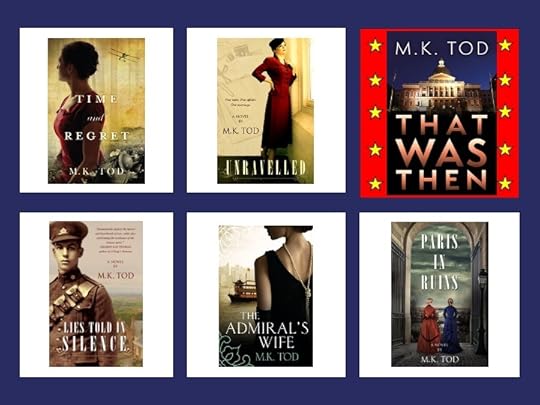
M.K. Tod writes historical fiction. Her latest novel THAT WAS THEN is a contemporary thriller. Mary’s other novels, THE ADMIRAL’S WIFE, PARIS IN RUINS, TIME AND REGRET, LIES TOLD IN SILENCE and UNRAVELLED are available from Amazon , Nook , Kobo , Google Play and iTunes . She can be contacted on Facebook or on her website www.mktod.com .
The post The Reading Journey with Erin Davies appeared first on A Writer of History.
November 18, 2025
History In Our Own Backyard
L.E. Denton .. also known as Laura .. has written Of Their Own Free Will, a novel exploring the early triumphs of Andrew Jackson through the lens of two men caught in the turmoil of war. Today Laura offers suggestions on using resources close to home when writing historical fiction.
~~~
History In Our Own Backyard by Laura DentonI’ve always enjoyed historical fiction. It takes one back to people, places and events that we read about and drives our curiosity to places alive in our own imaginations.
One of my favorite authors is Ken Follett, who takes his readers back to the English Middle Ages, where he explores human nature in settings we can picture in our minds’ eye. Oh, to have lived in those times, I sometimes think! How exciting it would have been to be a part of a time when the human condition changed so dramatically.
And yet, in my own writing journey, I am most keen these days on exploring what is close at hand. In my latest novel, “Of Their Own Free Will: Fort Mims to New Orleans”, I had the opportunity to explore and research the area where I now find myself living. I found it most intriguing to be able to drive to the places I was writing about and found myself enveloped in the story in ways I never have before.
It was a chilling experience to step into the reconstructed Fort Mims, where one of the worst massacres in American history took place. To stand on the ground that was once blood soaked gave me a sense of dread, as I thought about the lives lost there and where a whole chain of events began that would lead to a new era in our history.
Traveling by car to the Chalmette battlefield, where the Battle of New Orleans took place, I spent hours walking the field that once held thousands of troops, both British and American, uncluttered by monuments and statues, and got a greater sense of what actually transpired there. I believe that experience gave me a greater sense of urgency in my writing and a clearer idea of the events of January 1815.
We should be inspired by the past events that took place right where we are. It doesn’t matter where you live – history is there.
If you were to decide to join me in exploring the history of your area, I would first suggest you go to as many places where historical events happened as possible. Take time to contemplate your surroundings in solitude. Think about what types of individuals found themselves in the same surroundings in the past. What were their thoughts? Their emotions? Did they understand what was happening? What lead them to the same place where you find yourself today, in the present? Hopefully your musings will give you some inspiration and the beginnings of a story.
There are numerous resources all around us, if we just take the time to explore them. One of the greatest I found were local genealogy societies. Some of them have small libraries, rich in resource material. You will also find among their members people who have spent tremendous amounts of time researching their own families and have vast knowledge of the history of your area. Don’t be afraid to ask for help with your research. Many of them have members who are more than willing to share their knowledge with you.
Many libraries have local history sections. Here you will find books and other resources not readily available online. Many of their holdings are long out if print, and can be a bonanza of information. They may also have genealogical information as well. Genealogies can give you ideas on characters for your own writing. Some larger libraries will also have an archives department. These are an invaluable tool for you as you flesh out your storyline. Some archives have assistants that are employed to help you search through their materials. I found those assistants to be a huge help.
Even the smallest museums will have information that can give your writing a boost. Some of these will also have written material that you can use for research. I found by engaging in conversation with the people who work at these museums that they were very eager to share. Be open with them about your purpose there. Let them know you are researching to write a book. I’ve found people to be very eager to help once they learn your intent.
As I explored, I even found myself visiting graveyards! There are all sorts of clues about the people of the past on headstones and in family plots. Some will give you causes of death, while others will tell you a little bit about the people they honor. For instance, the oldest graveyard in the state of Alabama is in Mobile. By exploring it, I discovered the graves of many who perished from outbreaks of yellow fever in the early days of the settlement. By walking through it, I could spot the exact month and year of these outbreaks simply by reading the headstones.
Don’t be afraid to explore what you have near at hand. There are stories out there that demand a voice. Your voice. Use it!
 Of Their Own Free Will: Fort Mims to New Orleans by L.E. Denton
Of Their Own Free Will: Fort Mims to New Orleans by L.E. DentonIn the chaos of war, destinies are forged, loyalties are tested, and survival is never guaranteed…
Of Their Own Free Will: Fort Mims to New Orleans is a riveting exploration of the human spirit set against the tumultuous backdrop of the Creek War and the War of 1812. The narrative follows Jacob Worley, a man of mixed heritage caught in the crossfire of cultural conflict, and Pierre Durand, a traditionalist grappling with personal loss amidst the French ways of Mobile. As war ravages their homelands, both men are thrust under the command of a relentless leader, challenging the might of an empire and the course of destiny. This compelling tale of survival, sacrifice, and self-discovery tests the boundaries of loyalty and the resilience of the human spirit, offering a profound exploration of personal identity amidst the chaos of war
Many thanks for these straightforward and yet powerful suggestions, Laura. It reminds me of a small museum in northern France that I visited once and how a simple display inspired a scene in my first novel Unravelled.
FOR MORE ON READING & WRITING HISTORICAL FICTION FOLLOW A WRITER OF HISTORY. There’s a SUBSCRIBE function on the right hand side of the page.

M.K. Tod writes historical fiction. Her latest novel THAT WAS THEN is a contemporary thriller. Mary’s other novels, THE ADMIRAL’S WIFE, PARIS IN RUINS, TIME AND REGRET, LIES TOLD IN SILENCE and UNRAVELLED are available from Amazon , Nook , Kobo , Google Play and iTunes . She can be contacted on Facebook or on her website www.mktod.com .
The post History In Our Own Backyard appeared first on A Writer of History.
November 5, 2025
Death of an Officer by Mark Ellis
Author Mark Ellis has been on the blog before with articles featuring the world of police investigations during 1940s wartime England and the complications involved with American troops stationed in that country and an article on writing historical fiction. Those two posts shared news about Mark’s novels Merlin at War (renamed The French Spy) and Dead in the Water along with his recurring character Detective Chief Inspector Frank Merlin, a senior police officer working in Scotland Yard.
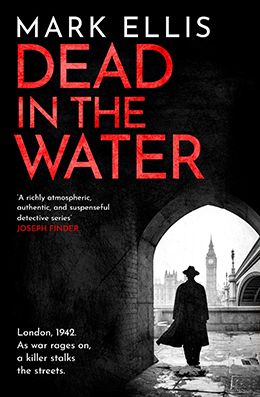
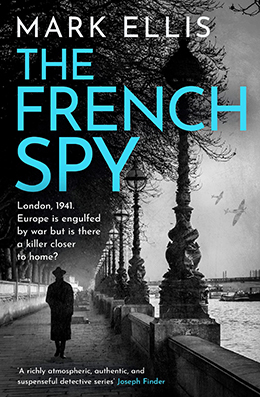
Today’s post is my review of Mark’s latest novel Death Of An Officer.
Mark Ellis has always been fascinated by WW2 and in particular the Home Front and the fact that while the nation was engaged in a heroic endeavour, crime flourished. He explores that part of the war’s history in his DCI Frank Merlin detective series.
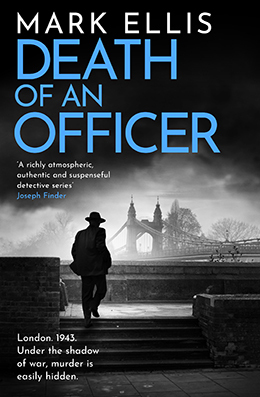 Death Of An Officer by Mark Ellis
Death Of An Officer by Mark EllisThe story begins, like many detective novels, with a murder. In this case, it’s the murder of a well-respected gynaecologist discovered by a cleaning woman. But hang on a moment – we soon discover that an American officer stationed in England is missing. Are the cases related and if so, how? Frank Merlin already has a heavy workload but this is wartime so he is assigned to both cases.
DCI Merlin and his team soon discover connections to gangland crime, a secretive club that moves locations with every meeting, unusual masks, and suspicious motivations.
Are the crimes connected? Is the missing American officer dead or alive? What secrets was the gynaecologist hiding?
One aspect that sets the novel apart is the spectre of WW2 that hangs over London. Mark Ellis deftly weaves military action and historic events into the story to add another layer of interest.
Mark Ellis also creates compelling characters who are critical to the novel’s appeal. They include British and American military personnel who are sometimes at odds and at other times cooperative, influential members of the aristocracy who as always expect special treatment, respected members of the medical community (another group impressed with their status and reluctant to expose a fellow physician), members of the criminal underground (a ruthless bunch), and, of course, Frank Merlin and his team.
The suspense is high. When combined with many twists and turns Death Of An Officer is a compelling, page-turning, wartime thriller. Highly recommended.
FOR MORE ON READING & WRITING HISTORICAL FICTION FOLLOW A WRITER OF HISTORY. There’s a SUBSCRIBE function on the right hand side of the page.

M.K. Tod writes historical fiction. Her latest novel THAT WAS THEN is a contemporary thriller. Mary’s other novels, THE ADMIRAL’S WIFE, PARIS IN RUINS, TIME AND REGRET, LIES TOLD IN SILENCE and UNRAVELLED are available from Amazon , Nook , Kobo , Google Play and iTunes . She can be contacted on Facebook or on her website www.mktod.com .
The post Death of an Officer by Mark Ellis appeared first on A Writer of History.
November 3, 2025
The Compelling World of True-Crime Historical Fiction
Author Maryka Biaggio is known for writing historical fiction inspired by real people whose lives illuminate the complexities of their time. She is the author of five novels. Her latest novel – Gun Girl and the Tall Guy – brings the true story of audacious robbers Celia and Ed Cooney to life amidst the world of 1920s Brooklyn. Don’t you love the title?
Here’s Maryka to talk about the world of true-crime historical fiction.
The Compelling World of True-Crime Historical Fiction: Why We Can’t Look Away by Maryka Biaggio
True-crime fiction has become a cultural phenomenon, captivating readers across generations with its unique blend of intrigue, psychological depth, and narrative tension. There are countless movies and television shows about true crime, and it’s a popular book genre, too. What drives our seemingly insatiable appetite for stories that delve into the darker corners of human behavior?
Before I started writing fiction, I was a psychology professor and clinical psychologist. So I can’t help but consider motivation, personality, and temperament when I’m considering subjects for my novels and writing characters. And that includes my perspective on true-crime historical fiction.
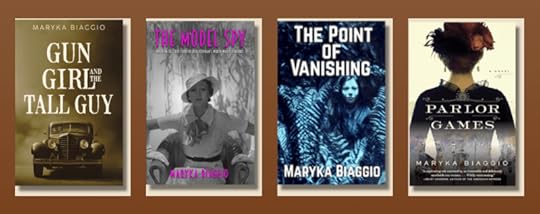
At the heart of true crime’s appeal is a complex psychological fascination. These stories offer readers a safe environment to explore the extremes of human nature. Most people lead law-abiding lives. Even if tempted by someone who, for instance, offers a big score with a bank robbery, most of us would turn down the offer for any number of reasons: religious beliefs, fear of punishment, aversion to social censure, and/or just plain ethical/moral principles. But that doesn’t keep us from wondering: What kind of people do succumb to the temptation or even seek out the adventure of crime?
True-crime fiction takes the reader inside the crime—into the mind, motives, and, yes, the possible apprehension of the criminal. The thrill of the chase, the unfolding of clues, and the suspenseful twists pull readers in. Moreover, these narratives often present compelling moral puzzles. They challenge our understanding of good and evil, demonstrating that human behavior exists in nuanced shades of gray. By presenting thoroughly researched accounts of crimes, authors invite readers to suspend judgment and engage in deeper psychological analysis of criminals.
The intellectual challenge of understanding criminal behavior also plays a significant role in our attraction to these stories. Readers become amateur detectives of sort, piecing together evidence, examining motivations, and attempting to comprehend the seemingly incomprehensible. Who doesn’t thrill to the vicarious experience of playing Sherlock Holmes or Miss Marple?
There’s also the appeal of justice and resolution and what psychologists call the just-world hypothesis, the tendency to believe that people generally get what they deserve. This cognitive bias leads us to think that good things happen to good people, and bad things happen to bad people. It’s a way of understanding the world that provides a sense of order, predictability, and control. So when criminals are apprehended and brought to justice, it’s because they deserved to be caught; all is right with our world. If we conduct ourselves in an honest and principled matter, we can expect no ill to come to us. (Of course, there’s a downside to this cognitive bias: We don’t really have control over what fate has in store for us. Bad things happen to good people all the time, and we really shouldn’t blame people who, by no fault of their own, for instance, become victims of crime.)
Of course, not all criminals are apprehended, and many historical crimes went unsolved or were shrouded in controversy. Just browse the numerous true-crime lists at Goodreads, and you’ll find scores of novels about Al Capone, Lizzie Borden, Bonny and Clyde, and the like. These fictionalized retellings allow authors to explore possible solutions, reimagine events, or even give voice to forgotten victims.
Historical crime fiction reveals not just individual psychological profiles but also social contexts that shaped criminal behaviors. They provide insight into how past societies viewed crime, morality, and punishment. Readers might learn about the moral hypocrisies of the Victorian era, the corrupt law enforcement of the Gilded Age, or the violent underworld of Prohibition. These historical settings provide a deeper understanding of how societies functioned and how justice—or lack thereof—was meted out.
In writing my novel Gun Girl and the Tall Guy, I had to grapple with many questions: How can I accurately portray the crime spree of this young couple without romanticizing their criminal activity? Why do people sometimes delight in hearing about successful heists? Are there ever any good reasons for stealing? What role do socioeconomic factors play in shaping criminal behavior? I hope I have painted a realistic portrait of the real people featured in Gun Girl and the Tall Guy, but ultimately it’s the reader who must answer all these questions.
I do believe that true-crime fiction is more than mere sensationalism. It’s a profound exploration of human complexity, social dynamics, and the intricate mechanisms of justice and morality.
Many thanks, Maryka. I too enjoy discovering the motivations of those who commit crime along with understanding the circumstances that drive their behaviour.
Maryka Biaggio’s most recent novel, Gun Girl and the Tall Guy, is available from Bookshop.org and on Amazon.
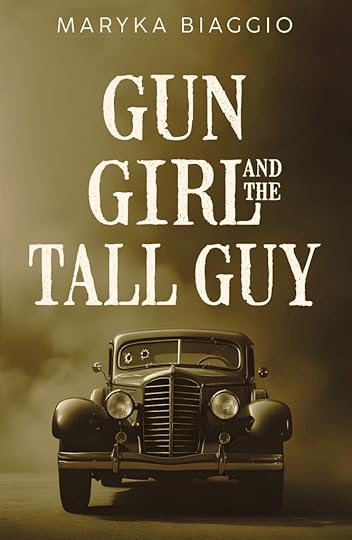
1924 Brooklyn—love, crime, and no turning back. Gun Girl and the Tall Guy tells the true story of Brooklynites Celia and Ed Cooney.
When newlyweds Celia and Ed Cooney discover Celia is pregnant, they pledge to give their baby a good life—but what’s a couple living in a cramped room on $30 a week to do? They start robbing Brooklyn businesses, much to the amusement of the city’s newspapers: A woman bandit is a true novelty in 1924 New York, especially a brazen, baby-faced woman toting a pistol. As the pair’s robberies become more audacious and the police bungle their attempts to nab them, the papers have a heyday with the police’s ineptitude. Increasingly humiliated, the police commissioner gives the order to shoot to kill. Will Ed and Celia elude the deadly dragnet of Brooklyn’s men in blue?
Gun Girl and the Tall Guy is based on the true story of Celia and Ed Cooney, who went on a crime spree in 1924 Brooklyn, stumping the police and amusing not only New York, but the whole country. The gun girl, aka the bob-haired bandit, and her handsome companion became regular fodder for daily newspapers. To learn more about Celia and Ed, visit https://marykabiaggio.com/book/gun-girl/.
Maryka Biaggio is featured in other posts: Eden Waits: A Novel About a Utopian Community, Characters Stranger Than Fiction, and WWII: Fascinating Behind-the-Scenes Facts.
FOR MORE ON READING & WRITING HISTORICAL FICTION FOLLOW A WRITER OF HISTORY. There’s a SUBSCRIBE function on the right hand side of the page.

M.K. Tod writes historical fiction. Her latest novel THAT WAS THEN is a contemporary thriller. Mary’s other novels, THE ADMIRAL’S WIFE, PARIS IN RUINS, TIME AND REGRET, LIES TOLD IN SILENCE and UNRAVELLED are available from Amazon , Nook , Kobo , Google Play and iTunes . She can be contacted on Facebook or on her website www.mktod.com .
The post The Compelling World of True-Crime Historical Fiction appeared first on A Writer of History.
October 30, 2025
Writing History – Symbols Matter
Some photos hit you in the gut. Monday’s photo of the destruction of the East Wing of the White House is one of those. As most of you know, I’m Canadian not American, but I’ve been to Washington and visited the White House – truly a monument to America’s history and democracy. What many call the People’s House.
For those who don’t want to read political posts, please check back for more historical fiction on the next post.

I guess they were wrong. Donald Trump has destroyed a major portion of that monument without consulting with anyone other than those in his administration. Without seeking the permission of Congress, which I understand he was supposed to do. Without any regard for what the building means to the people of America.
And why? We all know why. Because he wants a massive ballroom. It boggles the mind.
Now here’s another important part of the equation. Each of these people/organizations noted below donated money – yes, it’s always about money – and will have their names featured in some way throughout the new ballroom. Perhaps at the base of a column? Over a doorway? Beneath a window? By the way, almost every major news sources has published these names as well – but I wanted to investigate each name for myself to understand who they are.
 Colour-coding reflects motivation: billionaires, crypto currency investors and players, long-term and multi-million dollar Republican donors, major Trump campaign donors, leaders in the tech industry, corporations seeking deregulation, big government business, or special treatment, finance/hedge fund players.
Colour-coding reflects motivation: billionaires, crypto currency investors and players, long-term and multi-million dollar Republican donors, major Trump campaign donors, leaders in the tech industry, corporations seeking deregulation, big government business, or special treatment, finance/hedge fund players.Who are these people?
Altria Group – the owner of several major American companies with interests in tobacco products and wine, most notably Philip Morris IncAmazon – needs no explanation except that Amazon Web Services (AWS) provides cloud services to the US government, including federal, state, and local agenciesApple – I’m sure also a huge beneficiary of government purchasing; additionally, Apple CEO Tim Cook is promising to move some of its manufacturing back into the US to avoid tariffsBooz Allen Hamilton – holds numerous US government contracts, primarily Dept of Defense (now Dept of War) The company derives a significant portion of its revenue from this work. Caterpillar Inc – donated $1.4 million to the Republican party and spent $4.4 million in lobbying effortsCoinbase – Brian Armstrong CEO and Coinbase were major donors to a political action committee that helped Trump and other pro-crypto candidates during the 2024 electionComcast – owner of CNBC and other media corps; a major donor and lobbyist J. Pepe & Emilia Fanjul – major sugar can producers; lobbying with Trump’s encouragement to get Coca-Cola to use US produced sugarHard Rock International – Hard Rock International (owned by the Seminole Tribe of Florida) bought the Trump Taj Mahal casino for $50 millionGoogle – Trump is now targeting Google after Meta and X made payouts for lawsuits against those companiesHP Inc. – focuses on personal computers and printers with the US Federal Government as a major clientLockheed Martin – relies on government contracts in Defense/War and the US space programMeta Platforms – Mark Zuckerberg – one of the tech bros supporting TrumpMicron Technology – plans to invest approximately $200 Billion in semiconductor manufacturing and R&D in Idaho, New York and VirginiaMicrosoft – another tech bro; in September Donald Trump demanded that Microsoft fire former Biden Justice Department official Lisa Monaco, who Trump has previously blamed for federal investigations into his mishandling of classified documents and alleged election interference; could this be a clue?Nextera Energy – is an American energy company and the world’s largest electric utility holding company; energy is a major focus of the Trump administrationPalantir Technologies – in May, Donald Trump tapped Palantir to collect data on AmericansRipple – another crypto titanReynolds American – financial ties to Donald Trump, including significant donations to his political campaigns and inauguration. These donations are related to the company’s interest in influencing regulations, particularly regarding tobacco and e-cigarettes.T-Mobile – another tech companyTether America – Tether hired Trump’s top crypto official Bo Hines to help lead US Stablecoin expansionUnion Pacific Railroad – ahead of, yes, another merger … Union Pacific has a direct tie to Donald Trump through recent high-level meetings where Trump expressed support for its proposed merger with Norfolk SouthernAdelson Family Foundation – Miriam Adelson is worth $34.6Billion and since the 2010s has been one of the largest donors to the Republican party. In addition to wealth protection, she is a strong supporter of Trump’s support for Israel.Stefan E. Brodie – owner/found of Purolite, a chemical company … my guess is that deregulation is one of the important issues leading people like Brodie to support TrumpBetty Wold Johnson Foundation – the foundation is connected with Woody Johnson one of the heirs of the company Johnson & Johnson and owner of the New York Jets has contributed more than $4.7 million to Trump’s campaignsCharles & Marissa Cascarilla – Charles Cascarilla is co-founder of Paxos, a financial technology company delivering blockchain solutions for global financial institutions. Another crypto guy.Edward & Shari Glazer – Edward Glazer along with his brothers is an owner of Tampa Bay Buccaneers; significant Republican donorHarold Hamm – was a fundraiser and donor to Donald Trump’s 2016, 2020, and 2024 presidential campaigns; he is the owner of NextEra see aboveBenjamin Leon Junior – donated $2.5 million to the presidential campaign of Marco Rubio and has also donated to the Republican Party of Kentucky and Mitch McConnell; appointed ambassador to Spain by TrumpThe Lutnick family – this would be the family of Howard Lutnick who is now Trump’s Commerce Secretary; he has a long and close relationship with TrumpLaura & Isaac Perlmutter Foundation – in 2024 they donated $10 million to the newly formed Right for America super-PAC led by Sergio Gor in support of the Trump campaignStephen A Schwarzman – was chairman and CEO of the Blackstone Group, a global private equity firm; and chairman of Trump’s Strategic Policy Forum; a long time friend of Trump, he is also a billionaire Konstantin Sokolov – entrepreneur and investorKelly Loeffler and Jeff Sprecher – is the Administrator of the U.S. Small Business Administration (a Trump appointment) and a former U.S. Senator for Georgia, while her husband, Jeff Sprecher is the founder and CEO of Intercontinental Exchange, which owns the New York Stock Exchange; also major Republican donorsPaolo Tiramani – billionaire American industrial designer and entrepreneur; donated $10 million to Trump’s ballroom; runs a multibillion dollar housing companyCameron & Tyler Winkelvoss – cryptocurrency billionairesAs noted above, for the most part billionaires, crypto currency investors and players who want to deregulate and grow the industry, long-term and multi-million dollar Republican donors, major Trump campaign donors, a bunch of leaders in the tech industry, corporations seeking deregulation, big government business, or special treatment, and some finance/hedge fund players. Most of them fit in more than one category.
My expectation is that they’re all looking for some sort of payback – are you surprised? – through positions of influence, regulatory change, favourable tax reductions for the rich such as those proposed in the OBBBA, industry support, or ongoing government business.
These business leaders embolden Donald Trump by their willingness to dance to his tune.
History is unfolding before our very eyes. In my opinion, this history will not be remembered with admiration by future historians or historical fiction authors. Action is imperative to avoid further destruction of American democracy.
FOR MORE ON READING & WRITING HISTORICAL FICTION FOLLOW A WRITER OF HISTORY. There’s a SUBSCRIBE function on the right hand side of the page.

M.K. Tod writes historical fiction. Her latest novel THAT WAS THEN is a contemporary thriller. Mary’s other novels, THE ADMIRAL’S WIFE, PARIS IN RUINS, TIME AND REGRET, LIES TOLD IN SILENCE and UNRAVELLED are available from Amazon , Nook , Kobo , Google Play and iTunes . She can be contacted on Facebook or on her website www.mktod.com .
The post Writing History – Symbols Matter appeared first on A Writer of History.
October 28, 2025
A New Book Project
A Write of History, conceived in early 2012, now has over 1200 blog posts. At roughly 1000 words a post, that’s 1.2 million words. And let’s not forget the images – diagrams, cover photos, illustrations, images of paintings and maps and so on. A major overhaul of the site a few years back hopefully made the information more accessible to those interested in historical fiction and the look more appealing.
Yet the question remains – how does a reader make sense of it all?
The project I’m working on right now intends to answer that question with a book on mastering the seven elements of historical fiction. It’s in the very early stages – I’ve written five rough chapters.
Here’s a bit from the introduction. I won’t do my usual blue highlighting for emphasis or a quick scan. Your feedback would be very helpful.
~~
In 2015, I found a diagram that would change the direction of A Writer of History, the blog I began in 2012. The diagram – The Seven Elements of Historical Fiction – came from a website that no longer exists. I wrote a post about it which has now been viewed more than 50,000 times – not exactly viral, but significant in the realm of historical fiction authors.

PS … I plan to update this image.
Ever since discovering this diagram, I’ve explored those seven elements – character, dialogue, setting, world building, plot, conflict, and theme – in more than one hundred posts. Other historical fiction authors have written guest posts to add their perspectives on one or more of the elements. Collectively, there is now a sound body of knowledge based on the 7-elements concept. However, this ‘body of knowledge’ is not organized to make it easy for those writing historical fiction to take a comprehensive look at the elements.
And hence this book.
The seven elements are the backbone of a story, but the story itself remains the most critical element. So, let’s begin with a reminder of the power of stories, the unique role and purpose of historical fiction and thoughts on why we read and why we write.
Why do we read?
We read to gain knowledge, find advice and counsel, build self-awareness, develop motivation and strength, be entertained, create hope, seek escape or regeneration. We read to understand who we are and what we might become. We read to quiet our souls. We read to comprehend humanity, to build empathy for the experiences of others, to understand community and friendship, to appreciate how to live and die. Those are my thoughts. What do others say?
Novelist Trevor Byrne was part of a panel sponsored by the University of Cambridge that focused on the topic: Why do we read (and write) novels?
Trevor said: “Fiction brings you to places, emotionally and imaginatively, which you never otherwise would have visited.” Emotionally and imaginatively. Malachi McIntosh, another panelist cited Albert Camus in his response: “[Camus’s] core idea is that narrative art organises life in such a way that we can reflect on it from a distance, experience it anew and deny the transient nature of the everyday.” Author David Foster Wallace said, “fiction is about what it is to be a human being.” And finally, author E.A. Durden claims that “it is the job of fiction to portray the full spectrum of human possibility, to remind ourselves of everything we are capable of—from exploring the heavens to breaking out of the clink.”In Vineetha Mokkil’s article The Purpose of Fiction she writes: “a good novel or story gives us a better understanding of ourselves by drawing us into the lives of characters that have sprung from the writer’s imagination … Fiction is essential to the survival of the human race because it helps us to slip into ‘the other’s’ skin. It builds tolerance because it gives us an opportunity to see the world from different perspectives.”
Donald Maas, well-known literary agent, speaker, and author of fiction and non-fiction offered this perspective on fiction: “Fiction is about us. It captures our condition. It confronts us with our fears. It celebrates our human joys and triumphs. It’s a mirror, a telescope, a microscope, a record and a reminder. In it we discover what drives us apart and what binds us together.”
Historical fiction must do all this while portraying recognizable human characters who lived according to very different values, norms and customs, providing insight into their minds, and educating readers about the past. Done well, historical fiction allows modern-day readers to contemplate social, religious, and political change and to understand how the events of history have an impact on today.
These are seriously demanding objectives for writing fiction. And historical fiction adds another layer of complexity, that of bringing the past to life so that we can understand our past and the insights it provides to both our present and our future. And, of course, to enjoy a great story!
In 2017, I asked readers and authors to look under the covers of historical fiction and examine what sets the genre apart. Author Janie Chang: “Historical fiction adds context to modern-day social problems.” Author Geraldine Brooks: “Novels are about exposing the truth of who we are and who we have been.” Author Harald Johnson: “In my case, it’s about going back in time to not only see the differences, but to also see and experience our common humanity.”
Readers have stated their expectations too:
“World building is absolutely essential, and it is probably the deal breaker as far as I am concerned. I come to the book for the setting, I enjoy plot and characters, but if the world does not come alive for me as I read, I consider it a big letdown.”“Details have to be woven in seamlessly, so that it doesn’t come off as a contemporary novel dressed up in historical costume. Also, an author needs to give just enough description, but not so much that it weighs the reader down and interrupts the flow.” “History is concerned primarily with conflicts, winners and losers, and what historical fiction adds to a dry retelling of history is where it imbues the events of the past with characters who reach back in time to make it happen again for me, the reader.”The purpose of 7 Elements of Historical Fiction is to provide a framework for understanding the demands of successful historical fiction along with practical insights and guidance to writers and aspiring writers of this genre.
What can you expect?
To set the stage, chapter one presents a big-picture perspective on reading and writing historical fiction along with the value and purpose of this complex genre. This chapter includes input from well-known authors of historical fiction as well as insights from five comprehensive reader surveys.Chapters two through twelve offer an in-depth look at of each of the seven elements with four of these chapters dedicated to world building.Chapter thirteen examines the critical role research plays in bringing the seven elements to life within a story and the range of techniques and sources available to authors.Chapter fourteen positions the seven elements in the context of successful historical fiction and includes examples from award-winning novels.Each chapter ends with 10 tips – and sometimes more – for writers. These tips are intended as a handy reference and a summary of critical points presented in that chapter.Throughout the book you will find quotes from well-known authors as well as quotes from readers and book bloggers. You will also find diagrams – I love diagrams – and useful links to other relevant materials.7 Elements of Historical Fiction ends with reflections on two topics: Inside Historical Fiction (also known as what makes historical fiction tick) and Transported in Time and Place. Both are topics I explored through interviews with readers and authors.A question for you who visit A Writer of History – what do you think? Your feedback at this very early stage will be really helpful. Many thanks!
FOR MORE ON READING & WRITING HISTORICAL FICTION – and the occasional political post – FOLLOW A WRITER OF HISTORY. There’s a SUBSCRIBE function on the right hand side of the page.

M.K. Tod writes historical fiction. Her latest novel THAT WAS THEN is a contemporary thriller. Mary’s other novels, THE ADMIRAL’S WIFE, PARIS IN RUINS, TIME AND REGRET, LIES TOLD IN SILENCE and UNRAVELLED are available from Amazon , Nook , Kobo , Google Play and iTunes . She can be contacted on Facebook or on her website www.mktod.com .
The post A New Book Project appeared first on A Writer of History.
October 26, 2025
Important Message from author Kate Quinn
Author Kate Quinn posted a heartfelt, profound message about her husband’s military service on Facebook. I’m publishing it here to help get this message out. As many readers know, Kate is a celebrated author of historical fiction who has received many awards and accolades. Stephen serves in the US Navy.
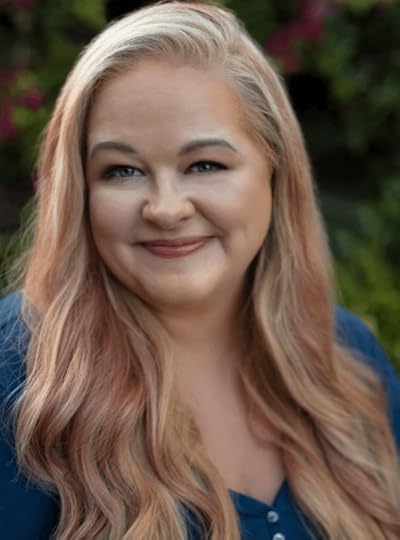

Kate Quinn: There is a particular heartbreak in watching someone see a heartfelt oath crumble.
My feelings about what is happening to this country are not complicated. My feelings are rage and bitterness and shame and all the shades of the rainbow in between. But I’m a civilian and I didn’t take an oath to uphold this country as my near-20-years-active-duty-Navy husband has done, and I’ve had the bitter occasion of watching his oath crumble before his eyes in real time, and it is heartbreaking.
Make no mistake, he made his oath–and has kept it, through multiple deployments and endless heartbreak–with eyes wide open and a critical gaze for this country he loves. He has always known that this nation is far from perfect; that it has much shame in its history and in its actions. He has always used that as a fundamental drive to be BETTER than the oath requires; to not be the swaggering selfish example of Americanism but the type that serves and represents humbly as well as fiercely. Every time he has gone overseas, my introvert of a husband turns into an extroverted diplomat learning cultural norms and customs so that people will never think worse of an American for having known him. Bahrani grandmothers adored him and taught him how to properly cook mutton; Japanese groundsmen taught him the micro-differences between levels of appropriate bowing; Pakistani sailors whom he helped save wrote his ship letters of thanks which now adorn our wall in frames. He’s managed–walking the line of patriotism and cynicism and honest service–to give nearly twenty years of his life in military service. That’s a lot of birthdays, Thanksgivings, Christmases, anniversaries and loved ones lost during deployments and overseas service.
And now it’s a lot of rage, as he watches the current administration burn down the government and hurt so very many of those he has sworn to protect. He’s answering the phone for suicidal service members who can’t get an appointment at the VA anymore because of DOGE. He’s bailing out vets with his own money when they can’t make rent, because they’ve been furloughed and are sitting with unpaid bills because Trump’s Congress doesn’t want to reopen the government and risk the Epstein files getting released (not to mention the terrifying prospect that broke Americans might get healthcare). He’s propping up gay and trans friends and service members who are terrified that they’re about to be targeted–he’ll probably be targeted too, since he’s openly bi and has been loud and proud about that for years to give support to young LGBTQIA+ Navy personnel who might need a mentor, but he doesn’t give a shit about being targeted. He has a fucking job to do. Not to mention that he’s watching the White House get bulldozed, and watching his oaths and twenty years of sacrifice get bulldozed along with it…and it’s breaking my heart.
His oath, as he constantly reminds any military personnel who seem confused on the topic, is fundamentally to the Constitution over the Presidency, period. “A 10 page document,” he’s said to me, “that tells us who we are, and more importantly, that we have the power to be better still. So what’s left if they burn that up? Some empty words and the promise of a pension?”
I wish I had a reply to that.
I wish I could make the people who support this current political madness reply to that. Because Stephen Wyckoff would have a two-hit fight with you: he’d hit you right in the face, and you’d hit the floor.
Like Indiana Jones, he loves punching Nazis.
~~
Mary: Just a few of my favourite Kate Quinn novels …
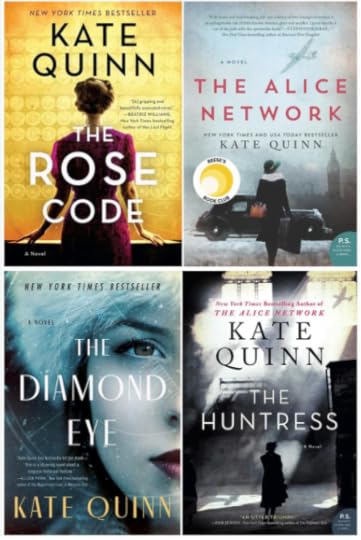
FOR MORE ON READING & WRITING HISTORICAL FICTION – and the occasional political post – FOLLOW A WRITER OF HISTORY. There’s a SUBSCRIBE function on the right hand side of the page.

M.K. Tod writes historical fiction. Her latest novel THAT WAS THEN is a contemporary thriller. Mary’s other novels, THE ADMIRAL’S WIFE, PARIS IN RUINS, TIME AND REGRET, LIES TOLD IN SILENCE and UNRAVELLED are available from Amazon , Nook , Kobo , Google Play and iTunes . She can be contacted on Facebook or on her website www.mktod.com .
The post Important Message from author Kate Quinn appeared first on A Writer of History.
October 22, 2025
The King’s Messenger by Susanna Kearsley
Another novel from the TBR list I created in July. This one is The King’s Messenger by Susanna Kearsley – and I have to tell you straight away that I loved it. Here’s the premise:
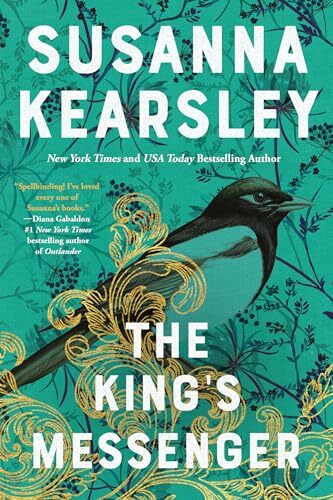
1613: King James – sixth of Scotland, first of England, son of Mary, Queen of Scots – has unified both countries under one crown. But the death of his eldest son, Henry, has plunged the nation into mourning, as the rumours rise the prince was poisoned.
Andrew Logan’s heard the rumours, but he’s paid them little heed. As one of the King’s Messengers he has enough secrets to guard, including his own. In these perilous times, when the merest suggestion of witchcraft can see someone tortured and hanged, men like Andrew must hide well the fact they were born with the Sight.
He’ll need all his gifts, though, when the king sends Andrew north to find and arrest Sir David Murray, once Prince Henry’s trusted courtier, and bring him a prisoner to London to stand trial before the dreaded Star Chamber.
A story of treachery, betrayal and love…
Susanna Kearsley often incorporates a bit of the supernatural in her novels whether through the gift of sight or a bit of time travel. As you can see from the book description above, The King’s Messenger is no exception.
Opening chapter – the story launches quickly into the animosity between Phoebe Westaway and Andrew Logan, the King’s Messenger. When I read it, I wondered if the novel was going to be mainly romance. You know the kind: man and woman dislike each other but at the end fall in love. However, there is soon intrigue enough with a mission from King James and hints of a conspiracy.
Compelling protagonist – four POV characters carry the story. Phoebe, Andrew, Anne who is Queen of Britain, and David Moray (Murray) who was Prince Edward’s tutor and confidant. Each character fascinates. Each voice adds intrigue and important insights. Although Anne appears less frequently – and does not accompany the group on their mission – she provides a valuable perspective of King James and of her son Prince Edward.
Interesting time period – definitely. While I’ve read many novels set during Queen Elizabeth I’s reign, I can’t recall any featuring King James I (of England) and King James 6 (of Scotland). The suspicious death of Prince Edward, the flawed character of King James, the King’s confidants who do his bidding while gaining influence and enriching themselves, the Queen’s virtual banishment from court – all fascinating story elements. The role of King’s Messenger dates a long way back in history. When Susanna Kearsley learned that these messengers were sometimes sent to arrest people, the character of Andrew Logan came to life.
Great pacing – we often think of page-turners as novels full of action and daring. The King’s Messenger doesn’t contain that kind of pacing, but for me, the characters and their circumstances were so interesting that I wanted to keep reading well past bedtime.
Engaging dialogue & balance between narrative and dialogue – definitely. And a great balance between action, dialogue and narrative. Beyond the four main characters, the story contains other people – although not too many – who add depth, wit, amusing circumstances, and conflict.
Meaningful themes – honour is a significant theme, family ties, love, abuse of power.
Great writing – Kearsley writes wonderful stories that immerse the reader in time and place. Her use of language adds to that sense of time and place without weighing down the narrative. Her characters quickly come to life. In The King’s Messenger Kearsley creates conflict and tension without resorting to sword fights or the 17th century equivalent of a high-speed car chase.
My conclusion? Highly recommended!
In 2017, I wrote a post based on a talk about dual-timeline novels that Susanna Kearsley gave at a conference – Weaving the Twin-Stranded Storyline.
By the way, did I mention that Susanna Kearsley is a Canadian author?
FOR MORE ON READING & WRITING HISTORICAL FICTION FOLLOW A WRITER OF HISTORY. There’s a SUBSCRIBE function on the right hand side of the page.

M.K. Tod writes historical fiction. Her latest novel THAT WAS THEN is a contemporary thriller. Mary’s other novels, THE ADMIRAL’S WIFE, PARIS IN RUINS, TIME AND REGRET, LIES TOLD IN SILENCE and UNRAVELLED are available from Amazon , Nook , Kobo , Google Play and iTunes . She can be contacted on Facebook or on her website www.mktod.com .
The post The King’s Messenger by Susanna Kearsley appeared first on A Writer of History.
October 16, 2025
The English Problem by Beena Kamali
A second novel from the TBR list I posted about in late July is The English Problem by Beena Kamlani. Here’s the blurb:
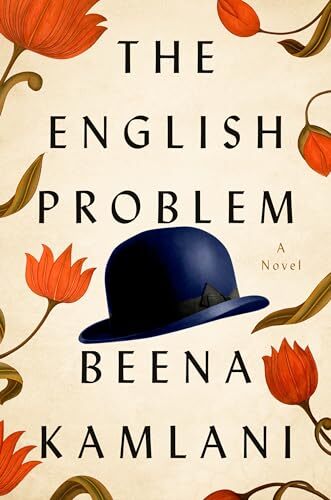
Book description: Shiv Advani is an eighteen-year-old growing up in India. But he is no ordinary young man. Shiv has been personally chosen by Mahatma Gandhi to come to England, learn their laws, and then return home and help drive the British out of India. Before he leaves, his family insists he fulfill his arranged marriage, and he is hastily betrothed to a young woman he hardly knows.
He arrives in London and soon discovers a world he is both repelled by and drawn to. Shiv knows his duty: get in, learn the letter of the law, get out. But as anyone who has ever lived in a British colony can tell you, “the English Problem” is multifaceted. The racist colonialism of “the empire on which the sun never sets” seeps into everything—not just landed territories, but territories of the mind: literature, language, religion, sexuality, self-identity. Soon the people Shiv sought to be liberated from will be the people he desperately wants to be a part of. In the end, Shiv must fight not only for his country’s liberation but also his own.
I selected The English Problem because it features an aspect of history I know little about – India’s road to independence from the yoke of British imperialism. I confess that the title also intrigued me, one could read so much into that title!
You might recall some of the criteria I use to select and assess the books I read:
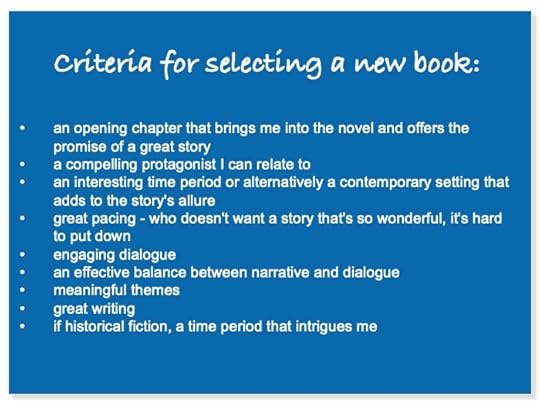
Shiv Advani – the main character of The English Problem – leapt off the page from the opening chapter. Even at a young age – 18 at the novel’s opening – he is dedicated to India’s desire for independence. But like many of that time and nationality, Shiv willingly accepts his parents’ authority and is honoured to be chosen by the famous and influential Mahatma Gandhi for service to his country.
We follow Shiv’s journey to England, his bewilderment and initial uncertainty, the way he gradually adapts, makes friends, and finds love. Chapters that reveal Shiv’s academic and career success, as well as his personal and emotional growth, are interwoven with somewhat mysterious chapters about a difficult return trip to India many years later.
The time period is early 1930s Britain – not entirely new to me, however, this novel reveals the darkness of British society at that time amidst emerging threats from Nazi Germany. Themes of nationhood, racism, striving for achievement, duty, and dedication to family and country are compelling. The emotional appeal of the story is significant.
Pacing? Every evening – did I tell you that I mainly read in bed? – I quickly immersed myself in Shiv’s story. And there were plenty of twists and turns and dramatic events that kept me turning the pages.
Balance? I occasionally grew impatient with descriptive passages or long bits of narrative, however, those did not detract from Shiv’s story, or perhaps I should say India’s story of independence.
Dialogue? Excellent.
Characters? Beena Kamlani has created a cast of memorable characters each of whom are critical to the story and its themes. There are people who support Shiv and his mission, two people Shiv falls in love with (I won’t say more about that!), university classmates who become lifelong friends and others who attempt to hamper his success. Shiv’s mother and father appear in the beginning chapters and later through Shiv’s thoughts or his reflections on their letters. They are a prominent and dominating factor in his life. Mahatma Ghandi is another critical character in the story and I enjoyed this look at his powerful influence on the country.
Great writing? Yup. Beena Kamlani is an excellent writer. Penguin Random House – or is that Random Penguin House (ha ha) – includes this statement: “The English Problem is so self-assured and ambitious, it is hard to believe it is a debut.”
Critique? Two items to comment on here. One is the parallel timeline where Shiv is returning to India by ship. This timeline felt awkward to me. Not present enough to appreciate the point the author is trying to make and not frequent enough to build tension or develop character. The second is the ending which, of course, I can’t reveal. It may be that I haven’t thought enough about the author’s purpose in choosing this particular ending.
Recommendation? An excellent novel. One I would highly recommend!
Next up, The King’s Messenger by Susanna Kearsley.
FOR MORE ON READING & WRITING HISTORICAL FICTION FOLLOW A WRITER OF HISTORY. There’s a SUBSCRIBE function on the right hand side of the page.

M.K. Tod writes historical fiction. Her latest novel THAT WAS THEN is a contemporary thriller. Mary’s other novels, THE ADMIRAL’S WIFE, PARIS IN RUINS, TIME AND REGRET, LIES TOLD IN SILENCE and UNRAVELLED are available from Amazon , Nook , Kobo , Google Play and iTunes . She can be contacted on Facebook or on her website www.mktod.com .
The post The English Problem by Beena Kamali appeared first on A Writer of History.
October 14, 2025
History is written by the victors
As you will read in today’s post below, Vanshika Jain is the 16-year old author of Letters to the Empire. She has also been named Youth Poet Ambassador of Allegheny County, 2024-25. Vanshika is passionate about social justice and amplifying youth voices. She is already active in projects supporting Ukraine, an institute for the blind, and those promoting a more inclusive society.
Welcome, Vanshika!
~~~
“History is written by the victors.”
Winston Churchill’s words have never sat well with me. Perhaps because they didn’t just shape what I was taught about my ancestry, they defined how the world continues to view so-called “Third World” nations. That quote isn’t just a fact of history; it’s a warning. It reminds us that the voices of the oppressed, the colonized, and the silenced are too often erased or rewritten.
My name is Vanshika Jain, and I’m the 16-year-old author of Letters to the Empire, a historical fiction novel born from the need to challenge that narrative. I wrote this book to reclaim the stories history tried to forget. Stories buried under colonial records, overlooked by textbooks, and neglected by public memory.

Determined to share history from the perspective of the victims rather than the victors, I began my research journey. Through an internship at the Library of Congress and work with the Gilder Lehrman Institute, I learned how to sort, digitize, and date archival documents. I sifted through slave journals, battlefield letters, court records, political transcripts, even wedding invitations and news clippings—piecing together a history too few know and too many ignore.
What I uncovered was devastating: evidence of deliberate policy failures and state-sanctioned neglect that led to the deaths of over 3 million Indians during the Bengal Famine. Events like the Amritsar and Jallianwala Bagh massacres weren’t isolated tragedies, they were part of a pattern of systemic violence and cover-up. Even today, estimates of the death toll carry a margin of error of over 300,000 lives.
After months of digging, I turned to the internet, expecting memorials or memoirs—some sign that the world remembered. But I found almost nothing. No comprehensive displays. Few first-hand accounts. Scattered fragments of grief, easily missed.
At my public high school in Pittsburgh, I read Orwell’s 1984 and Ayn Rand’s Anthem. In them, I saw what happens when truth is erased: silence leads to repetition. If history is forgotten, injustice returns.
So I decided to write it.
Not in a textbook or academic paper, but as a novel—accessible, human, and honest. A story for young readers and future changemakers. Because if the next generation doesn’t remember these tragedies, history will not hesitate to repeat itself.
My novel, Letters To The Empire is now available for purchase now on Amazon. The beginning of every chapter features a letter that I uncovered relating to the theme featured in the chapter. The book takes the reader back and forth between India and South Africa in a fast-paced way with many vividly drawn characters.
 Letters to the Empire by Vanshika Jain
Letters to the Empire by Vanshika JainLetters to the Empire is a sweeping historical fiction novel that reimagines the lives of real people living under British colonial rule in India and South Africa. Through richly drawn characters and interwoven narratives, the novel uncovers the often-silenced truths of imperialism-from the devastating Bengal Famine that claimed over two million lives under Winston Churchill’s leadership, to the covert trafficking of individuals for brutal plantation labor. Spanning generations and continents, Letters to the Empire is an unflinching exposé of the British Empire’s darkest legacies, told through the voices of those who endured its grip-and those who dared to resist it.
Many thanks, Vanshika. Such an impressive accomplishment. I wish you great success with Letters to the Empire and in your future endeavours.
FOR MORE ON READING & WRITING HISTORICAL FICTION FOLLOW A WRITER OF HISTORY. There’s a SUBSCRIBE function on the right hand side of the page.

M.K. Tod writes historical fiction. Her latest novel THAT WAS THEN is a contemporary thriller. Mary’s other novels, THE ADMIRAL’S WIFE, PARIS IN RUINS, TIME AND REGRET, LIES TOLD IN SILENCE and UNRAVELLED are available from Amazon , Nook , Kobo , Google Play and iTunes . She can be contacted on Facebook or on her website www.mktod.com .
The post History is written by the victors appeared first on A Writer of History.



